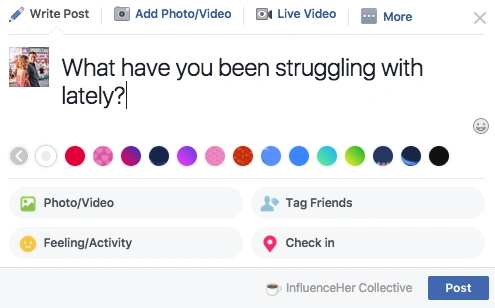There’s a huge difference between coming up with an online course idea and coming up with a good online course idea. For example, you could say, “Hey, I want to start teaching people how to tame and domesticate the wild ducks from their local pond.” And you could create an entire course on how to do that. But that’s something not many people may actually be interested in buying. Instead, maybe you could broaden your topic to team people how to hatch and care for ducks in an elementary school classroom. Now that might be more profitable and have more appeal.
Online courses are a great way to make money. But, you’ll only be successful if you’re making a course that your audience actually wants to buy.
A good online course idea will meet these criteria before you start creating:
- There is an audience for it
- It’s narrow enough that you can get nitty gritty
- You are an authority on the topic
- You’ve gone back and validated your course idea
Finding an audience for your course
Your first step in finding a good online course idea will be to find an audience. For example, if you’re passionate about dog training, it’s likely that you already frequent a few dog training forums or are part of Facebook groups where people share their experiences. And from there, you can start building a name for yourself as a helpful and knowledgeable community member.
For some niches, it may not be as simple as logging onto Facebook. Depending on your target demographic, you may be more likely to find your audience on forums, or subreddits, or even within certain Twitter or Instagram hashtags. The key is to find them before you start coming up with course ideas.
Why? Because you’re going to be able to use that audience to start finding profitable ideas for your online course.
Start simple
If you don’t know where to start looking for communities try starting here:
- Search for Facebook groups
- Subreddits
- Quora
- SlideShare
- YouTube
- Meetups
- Twitter /X hashtags
- Online forums
Once you know where your audience hangs out, start interacting. Answer questions people have and start networking.
Become a thought leader
More than growing your audience, you want to become a thought leader in your niche. This requires time and dedication. But it will help you gain a better understanding of your audience’s pain points while setting you up to have a successful online course launch.
Keep focused
If you’re truly trying to become a thought leader, it’s important not to spread yourself too thin. You’re better off developing a solid audience on one platform than you are developing a lukewarm audience spread across a handful of different social media sites.

The most important step you can take in becoming a thought leader is showing up consistently and actually providing value. Every time someone sees one of your posts or interactions, understand that it may be their first ever impression of you and you want it to be great from the start.
You’ll eventually find that people are asking the same questions over and over again. In that case, it’s beneficial to have an organized doc where you can keep the answers to common questions and group them together. When you see a question you’ve answered in the past you can easily copy and paste and in 30 seconds you’ve positioned yourself as an expert for the day.
Using your audience to choose a course idea
Once you’ve become active in the online communities, you can begin figuring out what you your audience’s pain points are and what online course topic would best serve them.
There are a number of ways you can do this. The simplest is to see what types of questions are being asked and notice consistencies. If you’re seeing that a third of the posts in your group all touch on the same topic, that’s a great place to start. You can also be more forward and ask people to share their pain points in a thread.

Once you’ve got an idea of what you’re struggling with, make a list of potential good online course ideas you can create based on those topics. Try to get nine or 10 to work with on the list.
Niching down your course idea
It’s time to start getting nitty gritty and decide upon the one transformation you want for your students. It might be tempting to say, “I’m going to create the ultimate supreme course to dog training.” However, it’s unlikely that you’ll actually be able to pack every single thing anyone will need to know about dog training into one, easily consumable course.
Instead, narrow it down.
Create a course on how to train an adult rescue dog, how to house train a puppy when you’ve got a full-time job, or how to potty train an older dog with a bell.
All of those topics are more narrow and help solve a specific pain point.
The short of it
A good online course idea is a shortcut to an outcome. And you’re better off if that outcome is a tangible change. Sure, it’d be great to make your students an expert on all things dog training. However, if you give them a focused course that will help them leash train their rescue dog in five weeks, that single improvement will be more valuable to them than a vague overview.
In other words: Don’t make your audience wade through a bunch of information that isn’t relevant to them.
Go four deep
When we talked to Joseph Michael, he mentioned going “four deep” with your online course idea. This means you should really narrow down your niche and hone in on a very specific pain point.
To stick with our dog training example, going four deep might look a little something like this:
- Dog training: This is your niche, but shouldn’t be your course topic. It’s too broad!
- Training adult dogs: This is better, but still very broad.
- Training adult rescue dogs: Now we’re getting somewhere….
- Training adult rescue dogs to walk on a leash: This might feel too specific, but that’s a good thing! You’re solving one very specific pain point that people are searching for.
Let’s look at another example. Now let’s pretend you want to teach people how to create a blog. Here’s how we’d go four deep. How to create:
- Blogs: This isn’t specific. What kind of blog? For what purpose?
- Profitable blogs: A bit better, now you’re targeting people who want to blog for profit.
- A profitable fashion blog: Even better, now you know what kind of content your audience will be creating and can cater your content to them.
- A profitable fashion blog with WordPress. Now we’re talking. This is specific and narrow and accomplishes a very specific goal.
Action step: Create a list of at least 10 course ideas that are narrow and specific within your niche. These course ideas should take your students to a clear outcome and all be topics you’d be excited to teach.
Narrowing down your options
Once you’ve come up with your 10 online course ideas, it’s time to narrow them down. First off, circle the five you’d be the most interested in teaching. Let’s focus on these. From there, you need to go back and reexamine what your audience really needs help with. Take into account how skilled they already are, and how long your ideal audience has already been in the industry.
Testing your top five
If you’ve got an email list, segment them into five sections to do somewhat of an A/B test. Send a short email with each course you’re considering as a title. Write a three or four paragraph mini-guide regarding that topic and see which performs better.
Take into consideration clicks and engagement.
If you’re looking for guidance, the five email subject lines you send might look something like this:
- House train your adult rescue dog
- How to leash train your adult rescue dog
- Socialize your adult rescue dog
- Crate train your adult rescue dog
- How to boundary train your adult rescue dog
Rely on data
Once your emails have been sent out to the segmented lists, wait a few days and collect the data. You’ll probably find that one or two emails got significantly higher open rates than the others and hopefully one of those got better engagement making your job a lot easier.
If they all performed really well or really poorly, your job just got a bit harder. If they performed well you can assume that your audience would be interested in any of them, if they didn’t you may have to go back to the drawing board.
If it ends up being the latter, go back and reanalyze your audience and challenge yourself to figure out why they weren’t interested in the topics you proposed. Once you’re better able to get into their head you can come up with ideas they will be interested in.
Proving you’re an authority on your topic
This is the hard part. When it comes to choosing and validating a good online course idea, a lot of people begin to suffer from “imposter syndrome.”
The one thing we can’t stress enough to online course instructors is: You don’t have to be an expert to successfully teach an online course. In fact, you’re often better served not to be an expert. After all, experts have often been in their field for decades and may not remember what it was like to be in their target audience’s shoes.
Being able to recall your own experiences and not gloss over the things that may be second nature to the “expert” is powerful, and why often times people who are newer to the field themselves create more helpful online courses.
“Great, but how do I relay that to my audience?”
You know what you’re capable of and the experiences you’ve had, now you need to prove to your audience that you’ll not only be able to help them but that you’re the best person for the job. If you’ve been around the Teachable blog for a while, you can likely anticipate what we’re going to say: Give something valuable away for free to prove your worth.
Using lead magnets to grow your audience
While we all are hoping to make money with our online businesses, it’s valuable to prove that you’re worth buying from by offering your audience a lead magnet.

This should be an online product you create that is in the same niche as the online product you tend to sell. You can give this away by offering it up in online communities, running Facebook ads, or promoting it in blog posts. Gate the content so that your audience has to give you their email in exchange for your lead magnet and you can start building your marketing list.
Examples of lead magnets:
- Toolkits/resource guides: Think of this as creating a shopping list. Walk your audience through everything they need to buy to be successful in what you’re teaching.
- Free mini-course: You can take the first module of the course you’re already creating and repurpose it into a mini-course, or create a mini-course on a complimentary, related topic.
- Checklists: Again, this can be like a shopping list, or it can be a checklist of skills your students should aim to master.
- Handouts: Think of this as the supplemental material you may have gotten in addition to your textbook back in high school.
- Downloads: Downloads work great for people teaching skills like design. Offer free templates or fonts for your audience to use.
- Worksheets: These can help your audience work through the preliminary steps they need to accomplish before being successful in your niche
- Webinars: We think webinars are one of the most powerful tools an online marketer has. They are the best way to make a connection with your audience and position yourself as an authority.
- Video series: Just as powerful as webinars, without the live aspect, videos are a great piece of content to offer.
- Podcast: Podcasts are having their moment right now, so if you can host a podcast that interests your target audience you can get ahead of the curve.
{{profitable-component="/blog-shortcodes/blog-popup"}}
With that said, keep in mind that the higher value your lead magnet is, the more your audience is going to trust you. You can easily throw together a checklist in 10 minutes and call it a day, but if you’re creating a detailed mini-course on a topic related to your paid course you’ll see higher conversions.
Coming up with what your free offering should be, though, is another story. You want your audience to be interested in learning more without giving them so much information that they feel that they have nothing left to learn.
Lead them on
First, we’ll continue with our shelter dog training example. Let’s look at some examples of great free lead magnets:
- Guide on rescuing dogs from the shelter
- Shopping list for first-time dog rescuers
- Mini-course on how to minimize aggressive behaviors with rescue dogs
All three of those options are targeted and valuable without taking any value away from your course itself. With that said, we’ve seen people successfully offer the first module of their online course as their lead magnet. As long as you’re transparent and let your audience know that’s what it is, this a great strategy to leave them wanting more from you.
Once your audience signs up to get your free resource, two things happen:
- They get content that they love and that helps them. This proves to them that you’re trustworthy, and in turn makes them more likely to buy when you have an online course or other product to sell to them.
- You get an email address to add to your list, which you can then use to either give them more free content or sell them something even more valuable.
If you’re really wanting to hook your audience, make sure that like your online course, your lead magnet will be taking your audience through a transformation.
Mini but mighty
Make it valuable but simple—something they’re going to appreciate but is all but fail proof. Being able to bring them a success early on will increase their faith in you and their faith in themselves to be successful in your niche. This combination will have them eager to learn more and they’ll trust that you’re the person who can help them reach their goals.
A few examples of mini courses or lead magnets you can create that will help increase your students’ confidence are a course or guide on:
- Meditation: Have your students sit down and meditate. Tell them that it’s OK to get distracted and give them tips on regrouping. Even if they get distracted they will feel accomplished for refocusing each time.
- Running a 5k. Take your students through a simple pre-run stretching routine. Even if they’re out of shape they can still sit down and successfully stretch. Provide alternative stretches for those who may not be flexible.
- WordPress. Help you audience set up a menu for their WordPress site. It’s simple but valuable and it’s hard to go wrong.
Validate your course topic
If you’ve successfully accomplished the last three steps, validating your online course idea should be easy. The idea of validating your course helps you ensure that your hunch that this is a topic your audience would be interested in is spot on. Validating your course idea can be as simple as sending an email to your audience, or a thorough process that involves pre-selling and marketing before actually creating your course.
Validating your course the easy way
If you’ve already built an audience and an email list, validating your online course idea could be as simple as sending in an opt-in to your email list. Let them know you’re working on creating an online course and if they’re interested in being in your first round of students to click the link you’ll provide and sign up for a segmented email list where they can get exclusive deals when your course goes live.
Your email list is the one platform that will convert better than anywhere else, so this a good place to measure your audience’s interest. Sending a one-off email likely won’t lead your entire audience to opt in, or even the entirety of your audience who is interested in your course. But it can show you if there is any interest at all.
If you have people opting in, great! That means there is interest. If not, you can send a follow up email to the people who opened the original one and see why they weren’t interested and what they’d rather see.
The world of pre-selling
If you don’t have an audience yet or you’re really trying to be sure that you’re on the right track with your online course you can try promoting a pre-sale. If you’re not familiar, a pre-sale is when you put your course sales page live before you’ve finished creating your course content.
You pre-sell so you can drip out your content and get feedback from a small batch of customers. Being able to collect feedback from a targeted audience who wants you to succeed is powerful because you can use that feedback to increase the value of your course and work out all of the kinks before you make your course available to the public.
Pre-selling has benefits that go beyond just validating your online course idea, too.
By pre-selling you:
- Won’t be wasting a ton of time. If your pre-sale flops and you realize your audience isn’t interested in your idea, you’re much better off if you haven’t poured your soul into 100% of your content. If you decide you don’t want to continue creating that particular course you can repurpose the content you did create and you won’t be at a loss.
- Get feedback as your audience consumes your course. After the first section goes live your audience might say that they prefer your screenflows over live video, or that the sound quality was a little wonky. You can take this early feedback and implement it into the rest of your course, catering the content to what your audience prefers. But more on that later.
- Are on a deadline. If you have a course full of eager students who are looking forward to weekly updates you’ll be much more likely to prioritize content creation and won’t fall behind.
- Can make money to improve your course. Pre-sales allow you to get audience feedback, and you may decide that you need to invest in a microphone or a better editing system to add value to your course. Now that you’ve made money pre-selling you’ve got a cushion to do so.
What if I can’t validate my course idea?
If you’re not getting the response you were hoping for, it can mean one of three things. You’re marketing:
- To the wrong audience
- The wrong course idea to the right audience
- The right course to the right audience who doesn’t know what they want
More often than not we find that it’s the second. If you’ve already built an audience, it makes more sense to create the products your existing audience wants rather than developing the course you hope an audience might want. If you didn’t get a positive response reach out and ask why. Consider using this email template:

You can use the responses that come from that email to decide what direction you want to take your online course. You can absolutely continue with the topic you originally planned on and start from scratch with audience building, but you’d be better off to adjust your offer and sell a product your current audience is interested in.
When your audience isn’t primed to buy courses
If you’re really certain that you’ve found the right course topic and the right audience but you still haven’t been able to validate your course idea, ask yourself why. You may find your audience isn’t primed to courses. Perhaps they’re unfamiliar with online courses as a whole. Or you’re focused in a niche where online courses haven’t been a “thing” in the past.
In this case, it’s up to you to educate them on what you’re teaching and why an online course can help them reach their goals. During the education phase, your goal is to make your audience want your product before they even know that you have a product. Make them want to know more about your course topic through engaging and valuable blog posts, email marketing techniques, and social media posts.
Get your audience excited
You can consider creating an entire email marketing strategy that starts off talking about why online courses are so effective in your area. Allow your audience to email you questions about online courses and be prompt and thorough in answering them.
Join more than 150,000 creators who use Teachable to make a real impact and earn a real income.








